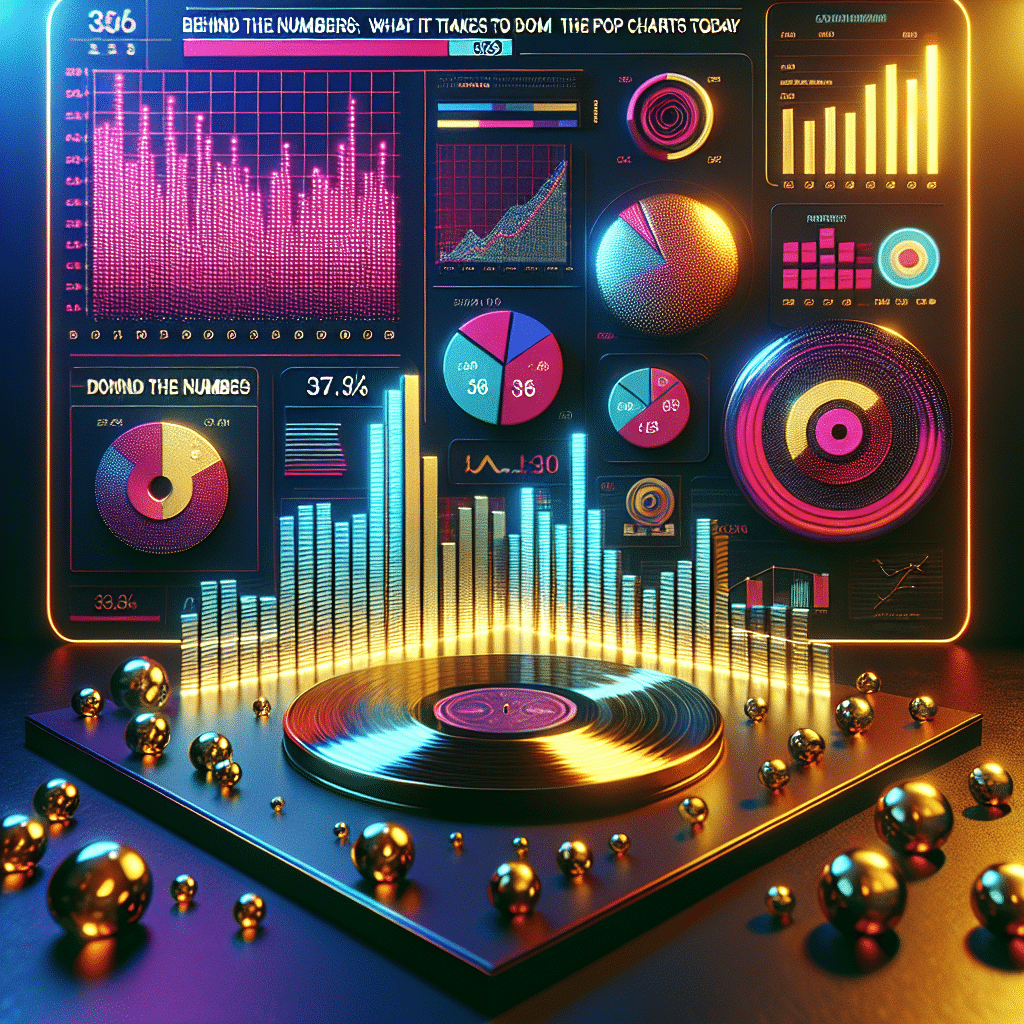Behind the Numbers: What It Takes to Dominate the Pop Charts Today

Introduction
The landscape of pop music is a continually evolving tapestry woven with diverse influences, technological advancements, and cultural shifts. As listeners become more discerning and platforms for consumption proliferate, the competition to top the pop charts is fiercer than ever. But what exactly goes into "dominating" these charts in the 21st century? This article takes a deep dive into the historical context, examines key artists driving current trends, explores modern industry dynamics, and assesses the cultural impact of contemporary pop music.
Historical Context
To truly understand what it means to dominate the pop charts today, we need to explore the evolution of pop music over the decades. The genre has roots in the 1950s rock and roll but has since absorbed influences from disco, hip-hop, electronic dance music (EDM), and beyond. The introduction of technology—particularly the internet and streaming services—has radically transformed how music is produced, marketed, and consumed.
In the 1990s and early 2000s, pop music was heavily characterized by physical album sales and radio airplay, with Billboard’s Hot 100 primarily reflecting these metrics. Iconic figures like Britney Spears and *NSYNC ruled the charts during this era, utilizing MTV and radio to cultivate large fanbases. However, the rise of digital downloads and, ultimately, streaming services in the mid-2000s ushered in a new paradigm. Today, platforms like Spotify, Apple Music, and YouTube play a crucial role in a song’s success, with streaming numbers often becoming part of the criteria for chart rankings.
Key Artists
See Also: Diversity and Representation: The Changing Face of Modern Pop Music
Diversity and Representation: The Changing Face of Modern Pop MusicToday’s chart-toppers are a combination of established industry veterans and innovative newcomers. Artists like Taylor Swift, Billie Eilish, and Ed Sheeran illustrate the diverse soundscape of modern pop, each bringing their distinct flavor while capitalizing on current trends.
Taylor Swift: Swift’s ability to shift genres—from country to pop to indie—illustrates adaptability and audience engagement. Each album release is meticulously crafted; marketing strategies such as surprise releases and engagement through social media have made her a prime case study in pop dominance in the streaming era.
Billie Eilish: Eilish represents a significant shift in aesthetic and sound, breaking away from traditional pop tropes. Her introspective lyrics and minimalist production resonate with younger audiences, demonstrating that authenticity can drive chart success. Eilish's success on platforms like TikTok has shown that virality can translate into significant chart performance.
- Ed Sheeran: With his knack for catchy songwriting and collaborations across genres, Sheeran has redefined what it means to be a pop artist. His strategic positioning—often releasing hit singles and collaborating with diverse artists—has allowed him to remain relevant in a rapidly changing music landscape.
These artists exemplify how blending genres, innovation, and engagement with fans is crucial for success in the current environment.
See Also: New Voices: Emerging Artists Who Are Making Waves in the Pop Scene
New Voices: Emerging Artists Who Are Making Waves in the Pop SceneCurrent Trends
The current trends dominating the pop charts reflect broader societal changes and technological advancements. Notable trends include:
1. Streaming Dominance
Music streaming has supplanted traditional album sales as the primary gauge of success. This has led to the rise of singles over full albums, as artists focus on producing tracks designed for playlists rather than cohesive albums. The charts now reflect immediate success, with viral hits often coming from platforms like TikTok.
2. Genre Fluidity
The lines between genres have blurred, with pop artists incorporating everything from trap beats to folk influences. This fluidity attracts a broader audience and keeps content fresh. For instance, collaborations between artists from different genres, like pop and country (e.g., Lil Nas X's "Old Town Road"), have gained prominence in chart-topping success.
3. Social Media Engagement
See Also: Pop Music’s New Wave: Rising Artists Making Chart History
Pop Music’s New Wave: Rising Artists Making Chart HistorySocial media platforms play a critical role in shaping artist visibility and chart potential. A significant proportion of successful songs today see initial boosts via TikTok trends, Instagram reels, or viral dance challenges. Artists harness their social media presence not only for promotion but also as a means of connecting directly with fans.
4. Diverse Representation
The contemporary pop scene emphasizes diverse voices and perspectives. Artists from various backgrounds—such as BTS from South Korea and Bad Bunny from Puerto Rico—show that global influences increasingly shape what constitutes mainstream pop music. This cultural diversity resonates with listeners and fosters a more inclusive industry.
Cultural Impact
The impact of dominating the pop charts today extends well beyond music. It influences fashion, social behavior, and cultural discourse. Hit songs are often accompanied by specific aesthetics that seep into mainstream culture. For example, Eilish's signature baggy clothing styles have challenged traditional body image norms, while the gravitation towards politically conscious lyrics often aligns with shifts in societal consciousness.
Moreover, the music industry often reflects and amplifies current social issues. Many pop artists are vocal about their beliefs, whether it’s advocating for mental health, climate change, or social justice, thus impacting youth culture and conversations at large. As music continues to be a soundtrack for the events of our lives, the importance of meaningful content in pop cannot be overstated.
See Also: The Clash of the Titans: Iconic Artists Compete for Chart Supremacy
The Clash of the Titans: Iconic Artists Compete for Chart SupremacyConclusion
In concluding, dominating the pop charts today requires an intricate blend of historical understanding, cultural awareness, and marketing savvy. Artists need to be innovative, adaptable, and conscious of their audience's preferences to succeed. The convergence of technological advances with evolving cultural expectations means that those wishing to top the charts must also consider their broader impact on society.
The significance of the dynamics behind today's pop charts lies not just in the music itself, but in how it reflects and shapes modern culture.
FAQs
Q1: What platforms are most influential for chart dominance today?
A1: Streaming services like Spotify, Apple Music, and YouTube play crucial roles in determining chart rankings. Social media platforms, particularly TikTok, also significantly contribute by making songs go viral.
Q2: Are traditional album sales still relevant to chart performance?
See Also: Pop Powerhouses: Artists Dominating the Charts in 2023
Pop Powerhouses: Artists Dominating the Charts in 2023A2: While album sales still count toward chart performance, streaming numbers have become the primary metric for success, leading to a greater focus on singles.
Q3: Why is genre fluidity important in pop music today?
A3: Genre fluidity attracts a wider audience and allows artists to innovate, keeping their sound fresh and relevant in a rapidly changing musical landscape.
Q4: How do artists engage with fans in the current music industry?
A4: Artists utilize social media to engage directly with fans, share personal content, and promote their music, fostering a sense of community and authenticity.
Q5: What role do contemporary pop artists play in cultural discourse?
A5: Modern pop artists often address social issues through their music and public personas, influencing cultural conversations and promoting awareness among their fanbase.
See Also: Top Tracks: The New Rap Releases Dominating the Charts This Month
Top Tracks: The New Rap Releases Dominating the Charts This MonthIf you want to know other articles similar to Behind the Numbers: What It Takes to Dominate the Pop Charts Today you can visit the category Pop.
